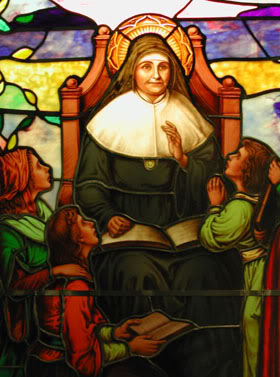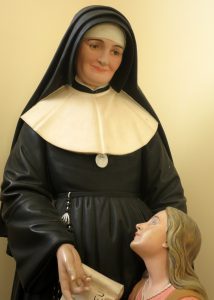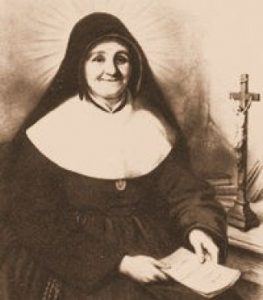
St. Julie Billiart was a teacher, a foundress, and a resistor of the anti-Church French Revolution. Julie was born in 1751, the sixth of seven children born to a prosperous farming family at Cuvilly in northern France. Even as a young child, she had a keen interest in religion and in tending to the needs of the poor. By the age of seven, she had memorized the Catechism. Naturally inclined to teach, she would round up her friends and teach them what she knew. Her education came from the village school, which her uncle operated. She was so exceptional in her knowledge of the faith, her pastor allowed her to receive Holy Communion and Confirmation at age nine, almost unheard of at the time for such a young girl. Also at this time, Julie made a vow of perpetual chastity. About that time, the fortunes of the family began to turn, and they gradually fell into poverty. To keep the farm going, the family members had to work long hours in the fields.
A born teacher
While the farm work consumed most of Julie’s teen years, she would find ways to continue teaching others in the Faith. In 1774, someone fired a gunshot at her father in her presence. While he was not actually struck, Julie was greatly traumatized by this event and eventually succumbed to a partial paralysis, completely unable to use her legs. Just twenty two years old, she became an invalid and was bedridden, remaining thus for twenty two years. During the duration of this mysterious illness, she received Holy Communion each day, followed by four to five hours of meditative prayer. She filled the remainder of her time making altar cloths by hand and continuing to teach religion to the children of the village who assembled around her sick bed for lessons.
Surviving the French Revolution
By 1790, the French Revolution was well underway, bringing a sharp division between clergy who were loyal to the Catholic Church and those who swore loyalty to the Revolution. In the village of Cuvilly, one of the schismatic priests was assigned to the parish, and Julie refused to allow him to visit her. Amazingly, from her sickbed, Julie was able to persuade the entire village to boycott the priest, stating that there should be no compromise with the state-sanctioned false Church. Priests who refused the oath were in constant danger of arrest and banishment to wretched prison ships, and despite the danger this put her in, Julie was known to provide refuge for clergy who were faithful to the Church. When Revolutionary authorities learned of Julie’s actions, it became necessary for her to leave, so she clandestinely escaped in a hay wagon. She found refuge at Amiens about fifty miles away.
A lifelong friendship begins
There, she met Francoise Blin, the Viscountess of Gizaincourt, whose entire family had been imprisoned during the Reign of Terror of 1793. Francoise recognized what a gift for teaching Julie possessed, and formed an informal school for some young friends. Julie, still an invalid, in addition to teaching the young women how to live their faith, also inspired them to do outreach to the poor. Julie and Francoise moved to Bettencourt, where they taught the Faith to the village, causing it to be restored where it had previously been wiped out. Under the leadership of the bishop of Amiens, the two women were placed under the direction of the superior of the Fathers of Faith, Fr. EnFantin. The women established an orphanage and continued their mission of educating poor children in the Faith. In 1803, the mission was given a name, the Institute of the Sisters of Notre Dame, and the first class of eight orphans was enrolled. Their particular mission was threefold: to form religion teachers, the education of girls, and the religious education of poor children.

Miraculous cure
In June of 1804, Mother Julie offered a novena. At its conclusion, Fr. EnFantin told her to stand up, and she did, after twenty two years of partial paralysis. Now quite able-bodied, she redoubled her efforts with Francoise (now Mother St. Joseph) to forming the sisters for the mission of teaching.
In 1806, the congregation was granted Church approval, and it started with just thirty members. From the Diocese of Amiens, the young congregation established foundation houses in other towns and cities in northern France and in Belgium. The spreading of the young order did not go smoothly, however. Their wise and supportive spiritual advisor was transferred from the area, and their new advisor and confessor set out to alter the constitution of the order substantially to be more like the monastic orders. The new advisor influenced the bishop of Amiens to also oppose the Institute’s constitution. Distressed, Mother Julie found support with the Bishop of Namur, Belgium, who invited her to make Namur the base for the Institute in 1809. Mother Julie remained at Namur for the rest of her life, forming young sisters for their mission of living in holiness and teaching the Faith to children. She died there April 8, 1816 after a three month illness. She was beatified in 1906 by Pope St. Pius X and was canonized in 1969 by Bl. Pope Paul VI.

St. Julie Billiart devoted nearly her entire life to teaching the Faith during and after the devastation of the French Revolution. By the time she died at age sixty four, fifteen convents of teaching sisters had been established due to her dedication and hard work. She possessed a great zeal for calling her spiritual daughters to holiness, in order to make their teaching effective. The congregation she founded is now known as the Sisters of Notre Dame de Namur and has houses in North and South America and Africa, as well as Europe. St. Julie is especially remembered on the date of her death, April 8.
